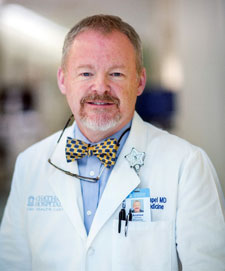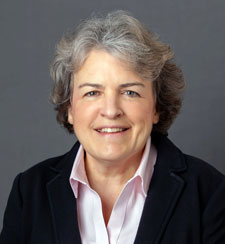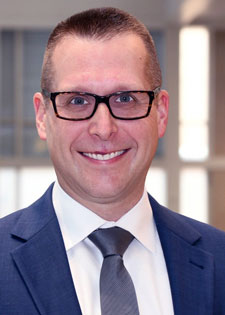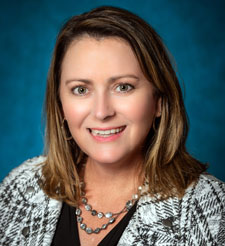
Dr. Hannapel
With the onset of COVID-19, the existing nurse shortage only worsened at many hospitals throughout the country. “COVID patients require an extra level of care due to the virus’s infectious nature and the need for isolation,” said Andrew C. Hannapel, MD, chief medical officer, director of medical education, and clinical provider in the emergency department, and hospitalist maternity care services for Chatham Hospital in Siler City, N.C. “Staff have to put on PPE each time they enter a COVID patient’s room. These patients require additional personnel and resources to care for them.”

Barbara Jacobs
All these extra demands impact nurses and other staff members over time. “Nurses are leaving bedside nursing and switching to outpatient nursing, non-patient care nursing jobs, or leaving nursing altogether,” Dr. Hannapel said. “Other nurses have left to become traveling nurses because of the substantial salary increase.” As a result of the COVID-19 vaccine requirement, the hospital lost close to 10% of its nurses.
Nurses’ burnout and frustration increased when challenges to mask mandates and vaccinations resulted in COVID-19 case surges over the summer. “Some nurses felt that the very people they sacrificed themselves for had failed them by not getting vaccinated,” said Barbara S. Jacobs, MSR, RN-BC, NEA-BC, vice president of nursing and chief nursing officer at Luminis Health Anne Arundel Medical Center in Annapolis, Md., an academic regional medical center with 380 beds.
The dramatic spike in COVID-19 cases in certain parts of the U.S. resulted in a tremendous demand for nurses and highly augmented hourly rates for temporary nurses, which contributed to fewer experienced nurses at the bedside in Jacobs’ hospital. Further, many female nurses had to provide childcare at home during the pandemic, which limited their availability to work, and another large group of nurses reached retirement age.
Now that the pandemic has significantly impacted the pediatric population, burnout has increased among the nursing staff at Akron Children’s Hospital in Ohio, an urban pediatric hospital with more than 400 beds. “More nurses are deciding to retire, while others are leaving the profession for other roles that are not direct care, especially hospital care,” said Christine Young, MSN, MBA, RN, NEA-BC, chief of hospital-based services and chief nursing officer. “Some nurses have taken assignments as traveling nurses, enticed by the financial incentives that travel agencies are offering, even though we have offered incentive bonuses.”
Effects on hospital medicine and patient care
Having fewer nurses increases demands on the hospital medicine department and negatively affects patient care. For example, Chatham Hospital, a rural critical access hospital with 25 beds, is unable to consistently keep all its beds open and staffed. Consequently, admitted patients are boarded in the emergency department until an inpatient bed is available, creating longer wait times there.
The hospital also hasn’t been able to keep its four-bed ICU open due to nursing shortages, which increases its transfers to larger community and academic hospitals. “But these referral hospitals have their own problems with staffing inpatient beds, so sometimes they can’t accept transfers or there are delays in accepting transfers,” Dr. Hannapel said.
At Akron Children’s Hospital, the primary impact on patient care because of the nursing shortage is occasional limits on

Christine Young
access. “We monitor the staffing situation continually and fortunately have rarely had to limit bed availability,” Young said. “When this does occur, we work closely with regional pediatric hospitals to ensure patients receive necessary care.”
The nursing staff works in close collaboration with its pediatric hospital medicine department. “Staff make every effort to work together so any shortage doesn’t impact its ability to deliver high-quality care,” Young said. “This shortage has strengthened our team; our hospital medicine colleagues are always willing to pitch in and work together with the nursing staff.”
For the first time in its history, Anne Arundel Medical Center brought in a lot of temporary staff. Consequently, team members were less familiar with each other than in the past. “Resource nurses are available to support less experienced or less familiar nurses, but there is a loss of experience that comes from team members who have worked together for long periods of time,” Jacobs said.
Health care practitioners in the department of medicine at Providence Mission Hospital in Mission Viejo, Calif., a community hospital with 502 beds, have been very supportive during the nursing shortage by conducting more frequent rounding, expanding training for new caregivers, and providing ongoing education about COVID-19 practice changes to the clinical team, said Cherie Fox, RN, MSN, CCRN-K, executive director of acute care services. “We provide and support the clinical team to push on and provide the same level of care regardless of the nursing shortage, COVID, or any other factors,” she said. All leaders are asked to round on patients, including everyone from its finance department to its quality team. “While care delivery is for the clinical team, checking on patients is everyone’s responsibility.”
Alleviating nursing shortages

Eric Wolak
There is good news as hospitals report some success in retaining and recruiting nurses. Chatham Hospital started offering sign-on bonuses for two-year commitments and relocation assistance for out-of-area candidates. It increased nurse salaries across the board by $2 per hour and will be giving a 2.5% raise to all employees beginning in January, said Eric Wolak, DNP, MHA, RN, NEA-BC, chief operating officer, and chief nurse officer. All nurses received an incentive bonus of 2.5% at the end of October. While it has tried not to become dependent on travelers, Chatham Hospital will be recruiting some for the ED to help ensure essential care. “It has become clear that graduate nurses will be our focus for recruiting new talent, so we have forged a strong relationship with an area community college with an RN program,” he said.
Chatham Hospital is also bringing back licensed practical nurses (LPNs) to inpatient and ED positions. “They are a community resource and have augmented our staff,” Dr. Hannapel said. “While they can’t do everything an RN can do and they require nursing staff to supervise and mentor them, they perform vital nursing functions. We also incentivize LPNs who earn an RN degree in four years by providing tuition assistance.”

Cherie Fox
Providence Mission Hospital has embraced a program called Transition into Practice (TIP), which has allowed it to onboard more new graduate nurses with better retention and clinical skills after orientation. The hospital offers sign-on and referral bonuses to recruit experienced nurses, but the bulk of the new positions are being filled with new graduate nurses who are provided lengthy, robust training, Fox said.
Fox said the hospital also created a patient care technician role for nursing students, which has helped with recruitment. This feeder program offers the flexibility of part-time work and schedule accommodations to cater to a nursing student’s needs.
Anne Arundel Medical Center offers tuition assistance and loan forgiveness programs in its effort to entice nurses. It also has an aggressive weekend program, both to reward nurses who work weekends and to build a team on those shifts, Jacobs said. This reduces the number of weekends that other staff need to work. The hospital has also adjusted its benefits. Its short-term disability waiting period has been reduced to seven days and staff members can receive full-time health benefits when working a 24-hour workweek.
At Akron Children’s Hospital, bonus incentive-pay programs are offered for staff who are willing to work extra hours, Young said. The hospital has reached out to retired nurses and other previous employees to recruit and rehire them. It created a Helping Hands program in which nurses working in non-clinical settings, such as information services, quality, research, and accreditation, have been offered refresher training to support clinical care delivery at the bedside. The hospital also actively reaches out to nursing students to offer them positions as patient care assistants to support care delivery at the bedside. “We use this strategy as a recruitment tool to retain and transition them to nursing positions when their schooling is complete,” she said.
Akron Children’s Hospital is also conducting accelerated market reviews to ensure its compensation is competitive, focusing on hard-to-fill and hard-to-retain positions throughout the organization including nursing, especially critical care nursing.
Forward thinking
Knowing the nursing shortage won’t be over any time soon, some hospitals are working on strategies to alleviate future shortages.
Capturing nursing students early in their schooling is key to lessening future nursing shortages, Young said. Akron Children’s Hospital has a robust nurse tech program, called Assuring Success with a Commitment to Enhance Nurse Diversity (ASCEND). It’s a 10-week program for nursing students from underrepresented groups before their senior year in nursing school.
It also has an accredited nurse residency program that supports new graduate nurses’ transitions to practice throughout the entire first year after graduation. “We know these transitions are difficult; this program has improved the first-year turnover rate for nurses significantly,” Young said.
Anne Arundel Medical Center is also looking to change some of the traditional ways of giving care and is exploring how it can provide optimal patient care with some innovative models. “We want to modify our models, adding increased and unique support staff roles,” Jacobs said. “We’re training a new generation of health care workers by partnering with various higher education institutions to offer a traditional and innovative educational pathway.”
Karen Appold is an award-winning journalist based in Lehigh Valley, Pa. She has also worked in a variety of capacities, including newspaper reporter, editor of a daily newspaper, and editor of a monthly magazine. Reach her at [email protected].
Nothing will change until hospital administrators stop deliberately shorting frontline staff to save money. We have all been working in skeleton crews and unsafe patient/staff ratios for years!! The fact is, patient safety is NOT the priority. Budgets are.